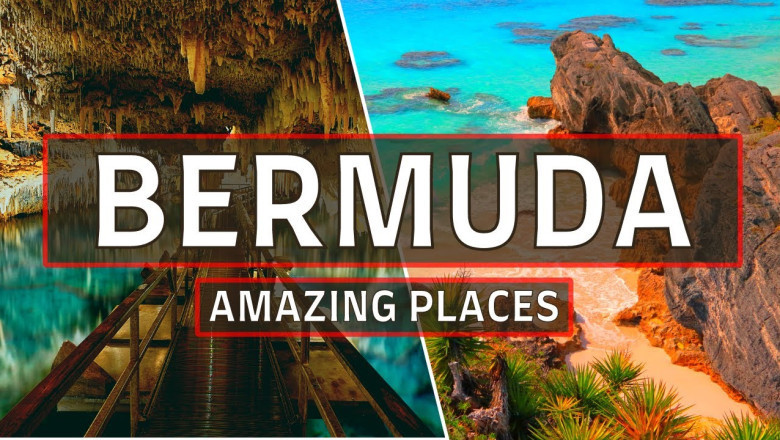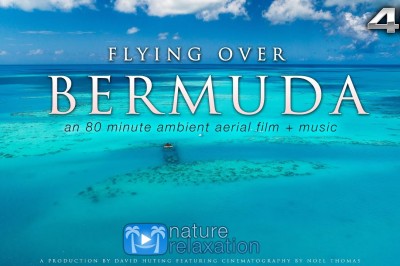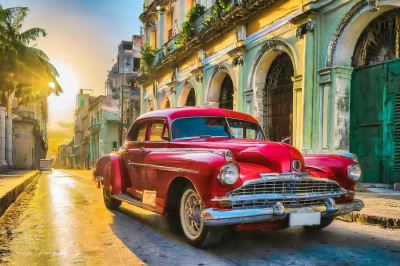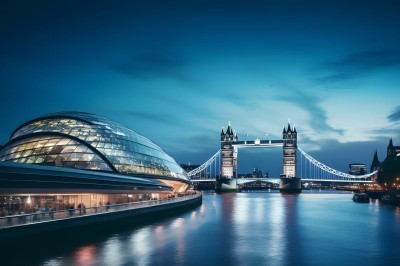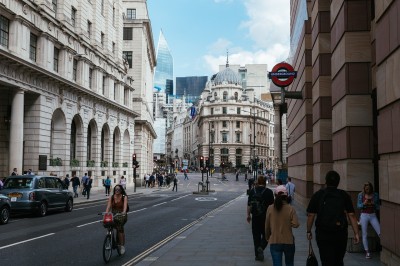Bermuda's Island Charm
Bermuda, a British island territory in the North Atlantic Ocean, is renowned for its pink-sand beaches, pastel-colored houses, and vibrant coral reefs. The island's charm is as much a product of its natural beauty as it is of its rich cultural heritage and friendly locals.
Enchanting Beaches
Bermuda's beaches are perhaps its most famous feature. The unique pink hue of the sand comes from the presence of crushed coral and shells, creating a stunning natural spectacle. Horseshoe Bay Beach is one of the most celebrated, but there are numerous secluded coves and stretches of shoreline to discover, each with their own character.
Lush Landscapes
Beyond the beaches, Bermuda's interior is lush and green. The island's subtropical climate allows for a diverse range of flora and fauna to thrive. Nature reserves, such as the Cooper's Island Nature Reserve, offer trails that meander through verdant forests, coastal mangroves, and salt marshes, providing a haven for birdwatchers and nature enthusiasts.
Historical Heritage
Bermuda's history is deeply embedded in its present. St. George's, a UNESCO World Heritage site, is the oldest surviving English town in the New World, with its winding alleys and historic architecture. The island's forts, like Fort St. Catherine, tell the tales of Bermuda's strategic maritime importance and its colonial past.
Maritime Mystique
The surrounding waters of Bermuda hold countless shipwrecks, offering a glimpse into the island's maritime mystique. Diving and snorkeling in these crystal-clear waters reveal submerged treasures and a kaleidoscope of marine life that is unparalleled in the North Atlantic.
Cultural Tapestry
The island's culture is a tapestry woven from British colonial influences and the heritage of African, Portuguese, and Native American ancestors. This blend is evident in Bermuda's music, dance, art, and cuisine, creating a rich cultural experience for visitors.
Architectural Delights
Bermuda's architecture is distinctive, with white limestone roofs designed to catch rainwater and pastel-colored walls that reflect the island's sunny disposition. The Bermuda roof is an iconic symbol of the island's ingenuity and charm.
Local Flavors
Bermudian cuisine is a reflection of the island's cultural mosaic, with fresh seafood taking center stage. Traditional dishes like fish chowder seasoned with sherry pepper sauce and the rum-soaked Bermuda Rum Cake are not to be missed.
Sporting Paradise
For the active traveler, Bermuda offers a range of sporting activities. The island is known for its world-class golf courses, sailing conditions, and tennis facilities. The annual Bermuda Cup Match and the prestigious America's Cup sailing race are highlights in the island's sporting calendar.
Community Spirit
The warmth of Bermuda's community is palpable at traditional events such as the Bermuda Day Parade and the Gombey dancers' performances. The island's spirit is infectious, and visitors often find themselves welcomed as if they were long-lost friends.
Tranquil Retreats
For those seeking tranquility, Bermuda's spas and wellness centers provide a peaceful retreat. The island's natural beauty contributes to a sense of calm and relaxation that complements the luxurious treatments offered.
Bermuda's island charm is a blend of its breathtaking natural environment, rich history, cultural diversity, and the warmth of its people. It's a place where adventure and relaxation coexist, inviting travelers to immerse themselves in the island's enchanting allure.
The Historic Town of St. George'sUNESCO World Heritage Site
The Town of St. George's, founded in 1612, is a remarkable example of the earliest English urban settlement in the New World. Its well-preserved colonial architecture and winding cobblestone streets earned it the designation as a UNESCO World Heritage Site. Visitors can step back in time as they walk through the town, experiencing a living museum that reflects the blending of European and African cultures over several centuries.
St. Peter's Church
St. Peter's Church, established in 1612, is the oldest continually used Anglican church in the Western Hemisphere. The church's original cedar beams and limestone walls stand as a testament to Bermuda's history and architectural resilience. Inside, the church houses a collection of historic artifacts, including a 1620 communion silver and a 1614 King James Bible.
Fort St. Catherine
Overlooking the stunning beaches of St. George's, Fort St. Catherine is a must-visit for history enthusiasts. This fortification, built in the early 17th century, has been restored and now houses a museum. The exhibits showcase the fort's military history, including antique weaponry and replicas of the Crown Jewels.
The Unfinished Church
The Unfinished Church, with its Gothic arches reaching towards the sky, is an evocative structure that tells a story of a congregation divided. Construction began in the 1870s but was never completed due to funding issues and disagreements within the church community. Today, it stands as a picturesque ruin, offering a unique backdrop for photographs and quiet reflection.
The Bermuda Perfumery
Established in 1928, The Bermuda Perfumery is an aromatic landmark located in the heart of St. George's. Visitors can take a guided tour to learn about the art of perfume making and witness the creation of fragrances inspired by the island's flora. The perfumery also offers workshops where guests can create their own signature scents.
Tucker House Museum
Tucker House Museum is a historic home that provides insight into the life of a prominent Bermudian family during the 18th century. The house is furnished with period antiques and features exhibits on domestic life, local history, and the Tucker family's genealogy. Of particular interest is the 18th-century mahogany furniture and a collection of Tucker family silver.
King's Square
At the heart of St. George's is King's Square, a bustling hub of activity surrounded by historic buildings. Here, visitors can witness reenactments of historical events, such as the dunking of a gossiping wench in the replica stocks and pillory. The square is also home to a variety of shops, cafes, and the Town Hall, which dates back to the 18th century.
St. George's Historical Society Museum
The St. George's Historical Society Museum, housed in a 17th-century building, offers a deep dive into the local history. The museum's collection includes Bermudian antiques, historical documents, and artifacts that tell the story of the island's development from the early days of colonization to the present.
Somers Garden
Named after Admiral Sir George Somers, who was shipwrecked on Bermuda in 1609, Somers Garden is a tranquil oasis in the middle of St. George's. The garden is the final resting place of Sir George Somers' heart, which, according to legend, was buried here while his body was returned to England. The lush greenery and peaceful atmosphere make it an ideal spot for a leisurely stroll or a picnic.
The Old State House
Built in 1620, The Old State House is the oldest stone building in Bermuda and was the first purpose-built session house for the island's Parliament. The building's architecture reflects the island's early colonial style and has served various governmental functions over the centuries. Although it is no longer open to the public, its historical significance and architectural beauty can be appreciated from the outside.
The Pink Sands of Horseshoe Bay BeachA Natural Wonder
Horseshoe Bay Beach is renowned for its stunning pink sands, a natural phenomenon that sets it apart from other beaches around the world. The sand's unique hue is the result of tiny red organisms called Foraminifera, which live on the underside of the coral reefs that surround the island. When these organisms die, their red shells mix with the sand and are washed ashore, giving the beach its distinctive pinkish color.
A Photographer's Paradise
The contrast of the pink sands against the crystal-clear blue waters creates a breathtaking scene that is a magnet for photographers and nature lovers. The best time to capture the true essence of the beach's color is during the early morning or late afternoon when the sun is low in the sky, and the light brings out the vibrancy of the pink sand.
Family-Friendly Shores
Horseshoe Bay Beach is not only a feast for the eyes but also a haven for families. The beach's gentle curve creates a natural cove that shelters visitors from strong currents, making it an ideal spot for swimming, especially for those with young children. Lifeguards are on duty during the summer months, ensuring a safe environment for all beachgoers.
Amenities and Accessibility
Visitors to Horseshoe Bay Beach can enjoy a range of amenities designed to enhance their beach experience. These include public restrooms, showers, and a beach rental stand where one can hire umbrellas, loungers, and snorkeling gear. The beach is also equipped with a wheelchair-accessible path, making it inclusive for visitors with mobility challenges.
Rock Formations and Hidden Coves
Beyond the pink sands, the beach is flanked by dramatic rock formations that not only add to the scenic beauty but also provide opportunities for exploration. Adventurous visitors can discover hidden coves and secluded spots perfect for a quiet retreat. The largest of these rock formations, known as Port Royal Cove, features shallow waters and is often populated with small, colorful fish, ideal for snorkeling.
Beachside Eateries
After a day of sunbathing and exploration, visitors can satisfy their hunger at the nearby beachside eateries. These establishments offer a variety of food options, from casual snacks to local Bermudian cuisine, allowing guests to dine with a view of the ocean and the sounds of the waves as a backdrop.
Seasonal Considerations
While Horseshoe Bay Beach is a year-round destination, the summer months are particularly popular, drawing crowds from around the world. For those seeking a more tranquil experience, the shoulder seasons of spring and fall provide milder weather and fewer visitors, while still offering the warm Bermudian hospitality and the stunning pink sands that make Horseshoe Bay Beach a must-visit location on the island.
The Mysteries of the Crystal CavesDiscovery and History
The Crystal Caves are one of Bermuda's most mesmerizing natural attractions, discovered in 1907 by two teenagers, Carl Gibbons and Edgar Hollis. The story goes that they were attempting to retrieve a lost cricket ball when they stumbled upon this underground wonder. Since then, the caves have been a source of fascination and exploration, drawing visitors from around the world to witness their beauty.
Geological Wonders
The caves are a testament to nature's artistry, featuring stalactites and stalagmites that have been forming for millions of years. The formations are made of white limestone, dripping with mineral-rich water that, over time, has crystallized into the stunning structures seen today. The highlight is the Crystal Cave's clear, azure-blue lake, which is approximately 55 feet deep and adds to the ethereal atmosphere of the cavern.
The Flora and Fauna
Within this subterranean ecosystem, a variety of life forms have adapted to the dark environment. The cave's fauna includes unique species of cave-adapted isopods and amphipods, which are small crustaceans. The flora is limited due to the lack of sunlight, but certain types of bacteria and algae thrive in the cave's humid conditions, contributing to the delicate ecological balance.
Visitor Experience
The Crystal Caves offer guided tours that allow visitors to safely navigate the cave's pathways and floating pontoon bridges. The lighting within the caves is strategically placed to highlight the dramatic formations and the crystal-clear waters below. The guides share insights into the cave's history, geology, and the ongoing conservation efforts to preserve this natural wonder for future generations.
Conservation Efforts
Preserving the Crystal Caves is of utmost importance. The delicate formations can be damaged by human contact, and as such, there are strict rules in place to protect the cave's natural beauty. Efforts include regulating the number of visitors, maintaining the walkways to minimize impact, and monitoring the cave's climate to prevent deterioration of the formations.
The Role in Bermuda's Culture
The Crystal Caves have become an integral part of Bermuda's cultural identity. They have inspired local folklore and stories, contributing to the island's mystique. The caves are also used as an educational resource, teaching locals and tourists alike about geology, conservation, and the importance of natural wonders.
Bermuda's Royal Naval DockyardHistorical Significance
The Royal Naval Dockyard in Bermuda is a bastion of maritime history, having served as the principal base of the Royal Navy in the Western Atlantic Ocean. Its construction began in the early 19th century, around 1809, as a response to the American War of Independence and the need for a strategic outpost for the British Royal Navy. Over the years, it played a pivotal role in various historical events, including the War of 1812 and both World Wars. The dockyard was designed to provide a secure berth and provisioning space for the British fleet, and it remained operational as a naval base until 1951.
The Keep and the National Museum of Bermuda
At the heart of the dockyard is The Keep, a fortified bastion that now houses the National Museum of Bermuda. The museum showcases a wide array of artifacts that chronicle Bermuda's maritime history, including exhibits on local culture, the island's role in global conflicts, and the evolution of seafaring and shipbuilding. Visitors can explore the Commissioner's House, which is the centerpiece of the museum, and offers panoramic views of the dockyard and the surrounding waters.
Maritime Activities and Attractions
The dockyard is not just a historical site but also a hub for maritime activities. Visitors can enjoy boat tours, sailing excursions, and even jet ski adventures that launch from the dockyard's marinas. The area is also home to the Bermuda Snorkel Park, where guests can explore the vibrant underwater life in the clear, turquoise waters of the Atlantic.
Shopping and Dining
The Royal Naval Dockyard is a premier destination for shopping and dining in Bermuda. The Clocktower Mall, housed in an iconic building with two prominent clock towers, offers a variety of shops selling local crafts, jewelry, and souvenirs. For dining, the dockyard boasts an array of options, from casual eateries serving traditional Bermudian dishes to upscale restaurants with gourmet menus, all set against the backdrop of historic buildings and the ocean.
Craft Market and Artisan Studios
The Bermuda Craft Market and the various artisan studios located within the dockyard provide a glimpse into the island's creative side. Visitors can watch local artisans at work and purchase unique, handcrafted items ranging from textiles and candles to cedar wood carvings and glassworks. These markets and studios not only offer one-of-a-kind souvenirs but also support the local economy and preserve Bermuda's cultural heritage.
Dolphin Quest
One of the most popular attractions within the Royal Naval Dockyard is Dolphin Quest, an interactive dolphin encounter experience. Guests have the opportunity to swim with dolphins, learn about their behavior and conservation, and participate in educational programs. This family-friendly attraction emphasizes the importance of marine life preservation and offers a memorable experience for visitors of all ages.
Events and Entertainment
Throughout the year, the Royal Naval Dockyard hosts a variety of events and entertainment options. From live music performances and cultural festivals to the traditional Gombey dancers, there is always something happening that reflects the vibrant spirit of Bermuda. The dockyard's open spaces and historic buildings provide the perfect setting for these community gatherings and celebrations.
Accessibility and Transportation
The Royal Naval Dockyard is conveniently accessible to visitors, with regular ferry services connecting it to Hamilton and St. George's. Additionally, taxis, minibuses, and rental scooters are available for those who wish to explore the dockyard and its surroundings at their own pace. The dockyard also serves as a major port for cruise ships, making it a first stop for many travelers arriving in Bermuda.
The Lush Beauty of the Bermuda Botanical GardensA Haven of Flora and Fauna
Nestled within 36 acres of verdant land, the Bermuda Botanical Gardens is a sanctuary for plant lovers and those seeking tranquility. As you meander through the gardens, you are enveloped in a tapestry of vibrant colors and diverse textures. The gardens are home to a collection of both native and exotic plants, showcasing the island's rich biodiversity. The subtropical climate of Bermuda allows for a variety of species to flourish, including endemic flowers that are not found anywhere else in the world.
Themed Gardens and Collections
The Botanical Gardens feature a series of themed gardens, each offering a unique experience. The Rose Garden is a romantic spot, with its fragrant blooms and picturesque layout. The Cactus Garden presents a stark contrast, with its array of spiky succulents and desert flora. For those interested in medicinal plants, the Herb Garden provides insight into the traditional uses of various herbs. The Sensory Garden is designed to stimulate all five senses, with plants selected for their scent, texture, and visual appeal.
Horticultural Highlights
One of the standout features of the gardens is the impressive collection of orchids housed in the Camden greenhouse. The delicate and sometimes rare orchids are a testament to the island's perfect growing conditions for these exotic beauties. The Palm Garden is another highlight, featuring a variety of palm species that sway gently in the island breeze, creating a serene and tropical atmosphere.
Educational Opportunities and Events
The Bermuda Botanical Gardens is not only a place of beauty but also a center for education and community events. The gardens host workshops, lectures, and tours that aim to educate visitors about plant science, conservation, and horticulture. Throughout the year, the gardens serve as a backdrop for art shows, cultural festivals, and seasonal celebrations, making it a vibrant part of the community.
The Masterworks Museum of Bermuda Art
Within the grounds of the Bermuda Botanical Gardens lies the Masterworks Museum of Bermuda Art, an institution dedicated to showcasing the island's art and artists. The museum's collection includes works inspired by Bermuda's landscape and culture, providing a cultural complement to the natural beauty of the gardens. Visitors can explore the galleries and then step outside to see the very flora that has inspired generations of artists.
A Sanctuary for Wildlife
The gardens are not only a haven for plants but also for wildlife. Birdwatchers will delight in the variety of bird species that can be spotted among the trees and shrubs. Butterflies flutter from flower to flower, adding a dynamic element to the garden's landscape. The ponds and water features within the gardens attract frogs and other aquatic creatures, creating a complete ecosystem where visitors can appreciate the interplay between plant and animal life.
The Garden's Historical Significance
The Bermuda Botanical Gardens have a rich history, having been established in Over the years, the gardens have evolved, but they continue to play an important role in the conservation of Bermuda's natural heritage. The historic structures, such as the Berry Hill entrance and the quaint garden cottages, add a sense of timelessness to the gardens, allowing visitors to step back in time and appreciate the enduring beauty of Bermuda's flora.
The Panoramic Views from Gibbs Hill LighthouseHistory and Significance
Gibbs Hill Lighthouse stands as one of the oldest cast-iron lighthouses in the world, having guided countless ships through the treacherous reefs surrounding Bermuda since its completion in Its historical significance is matched only by the breathtaking views it offers from its vantage point.
Ascending to the Top
Visitors willing to climb the 185 steps to the top of the lighthouse are rewarded with a 360-degree view of Bermuda's stunning landscape. The journey up the spiral staircase is an experience in itself, with historical exhibits lining the walls, providing a glimpse into the lighthouse's past.
The View from the Watch Room
Once at the watch room, the panoramic spectacle unfolds. To the east, you can see the crystal-clear waters of the Atlantic Ocean merging with the sky on the horizon. The northern view showcases Bermuda's lush vegetation and the vibrant rooftops of St. George's.
Overlooking the South Shore
Looking to the south, the famous pink-sand beaches of Bermuda's South Shore are visible, with Horseshoe Bay and Warwick Long Bay standing out as jewels among the coastline. The contrast of the turquoise sea against the blush sands is a photographer's delight.
The Great Sound and Hamilton Harbour
To the west, the Great Sound offers a stunning display of Bermuda's maritime activity, with yachts and ships navigating the waters. Beyond that, the cityscape of Hamilton Harbour presents a mix of modern and colonial architecture, set against the backdrop of the island's rolling hills.
Sunset and Sunrise Views
For those who time their visit right, the lighthouse provides an unrivaled spot to witness the sun rising or setting over the island. The play of colors across the sky and the reflection on the water create a magical atmosphere that is both serene and awe-inspiring.
Bird's Eye View of the Island's Flora and Fauna
From this elevated position, birdwatchers and nature enthusiasts can observe the island's diverse bird species in flight, as well as the rich flora that thrives in Bermuda's subtropical climate. The surrounding greenery and gardens are seen from above, offering a unique perspective on the island's natural beauty.
Navigational Landmark
The lighthouse itself, with its flashing beacon, is a key navigational landmark for vessels. From the top, visitors can appreciate the lighthouse's role in maritime safety and how it has stood the test of time as a guardian of the seas.
Interactive and Educational Experience
The lighthouse is not only a place to soak in the views but also to learn about Bermuda's maritime history. Informational plaques provide context to what you're seeing, making the visit both an educational and visual treat.
The Perfect Photo Opportunity
For those looking to capture the essence of Bermuda, the panoramic views from Gibbs Hill Lighthouse offer the perfect photo opportunity. Whether it's the vast ocean, the bustling harbors, or the tranquil beaches, each angle provides a snapshot of the island's diverse beauty.
Hamilton: The Heart of Bermuda's Culture and CuisineExploring the Vibrant Streets of Hamilton
Hamilton, the capital city of Bermuda, is a bustling hub of activity where the island's cultural heartbeat is most palpable. The streets of Hamilton are lined with a colorful array of buildings, each telling a story of the island's British colonial past blended with its vibrant island spirit. Visitors can explore Front Street, which runs along the harbor and is the face of Hamilton, offering picturesque views, especially when the sun sets and the pastel-colored buildings are bathed in a warm glow.
Art Galleries and Museums
The city is home to several art galleries and museums that showcase the island's rich history and artistic talent. The Bermuda National Gallery, located in City Hall, features collections of Bermudian and international art, while the Bermuda Society of Arts offers rotating exhibitions from local artists. The Bermuda Historical Society Museum provides a glimpse into the island's past, with artifacts and exhibits that tell the story of Bermuda from its early days to the present.
Local Performing Arts
For those interested in the performing arts, the Ruth Seaton James Centre for the Performing Arts and the Earl Cameron Theatre host a variety of live performances, including plays, dances, and concerts. These venues are central to Hamilton's cultural scene, offering a platform for both local and international artists to showcase their talents.
Culinary Delights in Hamilton
Hamilton's culinary scene is a reflection of its cultural diversity, with an array of dining options that range from traditional Bermudian dishes to international cuisine. The city's restaurants, cafes, and pubs offer a taste of the island's flavors, with seafood being a staple on many menus. Local delicacies such as fish chowder, spiny lobster, and Bermuda banana bread are must-tries for any food enthusiast.
Authentic Bermudian Cuisine
To truly experience Bermudian cuisine, visitors should seek out local eateries where dishes like cassava pie, a traditional Sunday meal, and codfish breakfast, a weekend favorite, are served. These dishes are deeply rooted in the island's heritage and offer a unique taste of Bermuda's culinary traditions.
The Buzzing Market Scene
The Hamilton Farmers' Market is a place where locals and tourists alike can immerse themselves in Bermuda's agricultural bounty. Fresh produce, homemade goods, and local crafts are available, providing a sensory feast and an opportunity to interact with the island's growers and artisans.
Festivals and Events
Throughout the year, Hamilton plays host to a variety of festivals and events that celebrate Bermudian culture. The Bermuda Festival of the Performing Arts, held annually, brings a range of cultural performances to the city, while the Bermuda Carnival, with its lively parade and music, showcases the island's festive spirit.
Nightlife and Entertainment
As night falls, Hamilton's nightlife comes alive with bars, nightclubs, and lounges offering entertainment ranging from live music to DJ sets. The city's nightlife provides a perfect way to experience the island's contemporary culture and mingle with both locals and visitors.
The Heart of Shopping
Hamilton is also the shopping heart of Bermuda, with an array of boutiques, shops, and galleries. Visitors can find everything from luxury goods to local handicrafts, making it the perfect place to search for souvenirs and gifts that reflect the island's culture and craftsmanship.
A Melting Pot of Cultural Influences
Hamilton's culture and cuisine are a melting pot of influences from the British, African, Portuguese, and American heritage of the island. This blend is evident in the city's architecture, food, art, and daily life, making Hamilton a microcosm of Bermuda's diverse cultural landscape.
The Serenity of Warwick Long BayUnspoiled Natural Beauty
Warwick Long Bay, located on the south shore of Bermuda, is renowned for its stunning natural landscape. The bay features a half-mile stretch of soft pink sand, which is one of the longest on the island. The beach is backed by sand dunes and native grasses, creating a picturesque setting that feels untouched by time. The clear blue waters are complemented by a coral reef that lies close to the shore, providing a vibrant underwater scene for snorkelers.
Secluded Atmosphere
Unlike the more popular Horseshoe Bay, Warwick Long Bay offers a sense of seclusion and tranquility. Visitors can often find a quiet spot to relax without the crowds typically found at Bermuda's more frequented beaches. The bay's length and the natural coves that dot the coastline provide numerous private enclaves for those seeking a peaceful retreat.
Ideal for Snorkeling and Swimming
The calm waters of Warwick Long Bay make it an ideal location for swimming and snorkeling. The offshore reefs are teeming with marine life, including colorful fish and intricate corals. The bay's gentle waves are suitable for swimmers of all levels, and the clear visibility in the water ensures a rewarding snorkeling experience.
Family-Friendly Amenities
Families visiting Warwick Long Bay will appreciate the available amenities. There are public restrooms and showers for convenience, as well as picnic tables for those wishing to enjoy a meal with a view. The beach's gentle slope into the water is safe for children, and during the summer months, lifeguards are on duty to ensure everyone's safety.
Access to Walking Trails
For those looking to explore beyond the beach, Warwick Long Bay is connected to a network of walking trails. These trails wind through the surrounding natural reserve, offering stunning coastal views and the opportunity to observe local flora and fauna. The trails are well-maintained and suitable for casual walkers and nature enthusiasts alike.
Photographic Opportunities
Photographers will find Warwick Long Bay to be a treasure trove of scenic shots. The contrast of the pink sand against the turquoise water creates a striking visual effect, especially during sunrise and sunset. The natural rock formations and the panoramic ocean views provide endless opportunities for capturing the essence of Bermuda's beauty.
Proximity to Other Attractions
Situated near other notable attractions, Warwick Long Bay is conveniently located for visitors looking to experience more of Bermuda's charm. Just a short walk away is the famous Jobson's Cove, a sheltered and serene spot perfect for swimming. Additionally, the Southlands Estate, with its lush gardens and historic buildings, is within close proximity, offering a glimpse into Bermuda's colonial past.
The Adventure of Snorkeling at Church BayDiscovering the Underwater Wonderland
Church Bay, located on the southwest coast of Bermuda, is renowned for its exceptional snorkeling opportunities. The bay's crystal-clear waters and vibrant coral reefs create an underwater tapestry that is both mesmerizing and teeming with marine life. Snorkelers can expect to encounter a variety of fish species, including parrotfish, angelfish, and the elusive butterflyfish. The reefs here are shallow and close to the shore, making them easily accessible for both novice and experienced snorkelers.
The Coral Reefs and Marine Life
The coral reefs at Church Bay are some of the most colorful and well-preserved in Bermuda. The bay's natural geography protects these reefs, providing a sanctuary for the marine ecosystem. The reefs serve as a habitat for a multitude of organisms, from the tiny, intricate Christmas tree worms to the larger, more majestic sea fans and brain corals. This rich biodiversity is a highlight for snorkelers, offering a glimpse into the complex and vibrant underwater world.
Snorkeling Conditions and Best Times to Visit
Church Bay's waters are typically calm, with the best snorkeling conditions present during the summer months when the water temperature is warm and inviting. The bay is relatively sheltered, but it's important to be mindful of the weather and ocean currents. For the clearest visibility and the most enjoyable experience, it's recommended to snorkel during high tide when the water is at its deepest over the reefs.
Equipment and Safety
Visitors can bring their own snorkeling gear or rent equipment from nearby vendors. It's crucial to ensure that the gear fits properly to avoid any discomfort or safety issues while exploring the reefs. Additionally, snorkelers should always be aware of their surroundings and follow standard safety practices, such as snorkeling with a buddy and staying within their comfort zone.
Environmental Considerations
Church Bay, like all natural habitats, must be respected and preserved. Snorkelers are encouraged to practice responsible tourism by not touching or standing on the coral, as this can cause significant damage to the fragile ecosystem. It's also important to avoid feeding the fish, as this can disrupt their natural behavior and diet.
Access and Amenities
Access to Church Bay is straightforward, with public transportation options available and a car park for those driving. The bay features amenities such as restrooms and picnic areas, making it convenient for visitors to spend the day. There are also shaded areas provided by cedar trees, offering a respite from the sun between snorkeling sessions.



